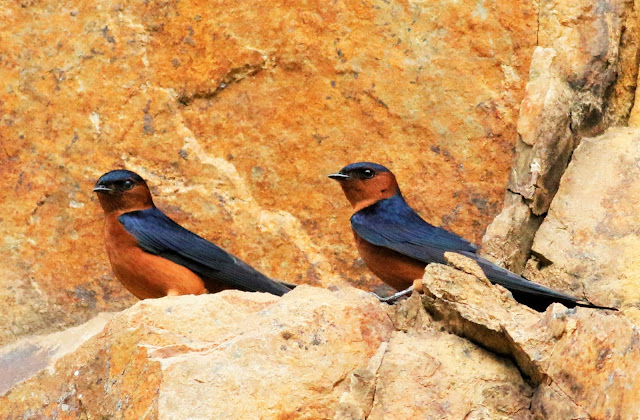Unlike the earlier swiftlets (Germani and Fuciphaga), majority of swallows are more conspicuous in their plumage. Barn Swallow was one of them.
A photo of a juvenile Barn Swallow with all the typical features associated with it - pale face and pale chest area, whitish underparts and shorter tail streamers (partly hidden)
Although the above photos were mainly juveniles, you should somehow able to differentiate them out from other swallows. However things may get a bit complicated if you wish to go a bit deeper into identifying its subspecies. Here is what i meant.
This could be the common Hirundo rustica - pinkish underparts/body. Apparently there are six (6) recognised subspecies but at the moment i believe only two subspecies occur in Malaysia.
Here are some recent photos of a Barn Swallow - taken in KL - April 2016
It would be near impossible to take a decent photo of them when they are in a feeding frenzy. Best times would be when they are in a cruising mode.
Check out its additional tail streamers
Just like the above Barn Swallows, it should not be too difficult as well to identify these "Rufous-Bellied Swallow" - subspecies of Badia.
Apparently these species of swallow is considered a "resident" swallow but the intriguing thing is that you will only be able to see them during certain times of the year i.e usually in December to January and usually in the company of other migrant birds such as the Barn Swallow (pers obs).
The features of the following swifts can be a bit tricky in the field. However with some careful observation, you should also be able to differentiate them as well.
The above photos show a single House Swift (Apus Afinis) - identified from its whitish throat and white rump-band - easy right ?
The ones below were taken in KL - March 2016
Unmistakable features
The next swift however would need a bit more of your closer attention.
Not easy wor !
Now i believe you should be able to identify it as a 'Black-nest Swiftlet' (Collocalia maxima / Aerodramus maximus) - stockier body and lacks tail notch.
This final swift should be quite easy.
Yup ! its a Forked-tailed Swift.
Presently there are four (4) recognised subspecies i.e i) Pacific Swift (Apus pacificus), ii) Salim Ali's Swift (Apus salimali), iii) Blyth's swift (Apus leuconyx) and iv) Cook's Swift (Apus cooki). From the description available in field guides and literature, the above swift should be a Pacific Swift (Apus pacificus) which is noted for its long distance travelling from the far regions of the Northen Palearctic.
I believe every living creature in this world have existed for a reason or perhaps a few reasons. Swift and swallows are here not only for its beauty and splendour but they could have a more important role in eradicating unpleasant and potentially harmful airborne disease carrier insects such as mosquitos.
HAPPY BIRDING !

























1 comment:
I have signally failed to capture swifts and needletails in flight. It might be my $270 camera. I live in Negeri Sembilan, and if you ever come down here to bird, let me know ahead of time, and maybe I can join you. Whatsapp at 601116337543. I am on Ebird as Eugene Prewitt
Post a Comment